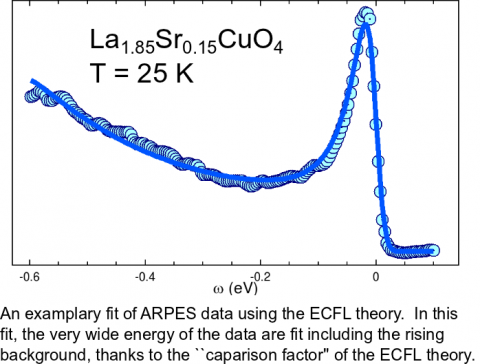
High-temperature superconductors are known for their "strange metal phase,"' which presents a rich but strange set of phenomena that challenge understanding. A requirement for building a correct theoretical model of high temperature superconductors is that this strange metallic phase be explained first. One of the defining characteristics of the strange metal phase is the anomalous line shapes measured by angle resolved photoelectron spectroscopy (ARPES).
There have been major theoretical efforts to explain the anomalous ARPES line shapes. For example, the marginal Fermi liquid theory by Varma is one. The hidden Fermi liquid theory by Anderson is another. However, although serious and successful fits to the ARPES data have been reported by these theories, the ARPES field has been experiencing something of a conundrum recently.
The conundrum has to do with the recent advent of laser-based ARPES, as opposed to the conventional synchrotron-based ARPES. Utilizing low energy photons, laser-based ARPES has shown to be capable of producing very sharp peaks in comparison to synchrotron-based ARPES. Because of this reason, a dichotomy seems to be emerging. Some theories (e.g. marginal Fermi liquid theory) fit synchrotron-based data very well, while other theories (e.g. hidden Fermi liquid theory) fit the sharp laser ARPES data very well.However, which kind of data—the synchrotron data or the laser data—is better is a highly ambiguous question. Both techniques have pros and cons. Synchrotron data are better in that they satisfy better the high photon energy requirement of the so-called ``sudden approximation theory'' of ARPES, a baseline assumption for all line shape analysis theories. Laser data are better in that they offer greater bulk sensitivity.
There then emerges a third possibility. What if there is a theory that is capable of fitting both kinds of data? In addition, what if that theory also has other features such as satisfying particle sum rules and explaining ARPES dispersion anomalies (known as ARPES "kinks")? What if that theory is derived painstakingly as a novel solution of a very tough-to-solve strongly correlated electron model such as the so-called "t-J model"?
The work led by Gey-Hong Gweon at UC Santa Cruz, based on the data obtained at the Stanford Synchrotron Radiation Lightsource, in collaboration with the theorist Sriram Shastry, says yes to all these questions, providing a fresh new perspective on the strange normal state of high temperature superconductors. The novel solution by Shastry is termed an "extremely correlated Fermi liquid," fully described in a separate paper published back to back. While this solution was derived from the "t-J model," a major theoretical model that is used by many researchers, its spectral function is unique and unprecedented. Gweon has demonstrated that this novel spectral function works extremely well across techniques and samples.
If the success of this research can be expanded to include a wider range of temperature, momentum, doping, and materials, our understanding of the strange metal phase of high-temperature superconductors, and subsequently our understanding of the high-temperature superconductivity problem, will be significantly expanded.
Acknowledgments
Funding for this work was provided by the U.S. Department of Energy.
B. Sriram Shastry "Extremely Correlated Fermi Liquids" Phys. Rev. Lett. 107, 056403 (2011)
G.-H. Gweon, B. S. Shastry, and G. D. Gu "Extremely Correlated Fermi-Liquid Description of Normal-State ARPES in Cuprates" Phys. Rev. Lett. 107, 056404 (2011)




